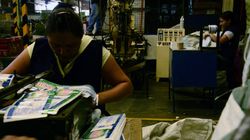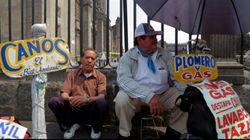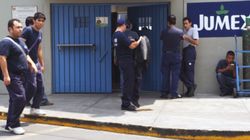Mexiko City|Mexiko
Statistische Daten
Google-Einträge für Mexico City, Ciudad de México
Ciudad de México Distrito Federal, México, D. F. 169.420.000
Google-Einträge pro Einwohner (Stadtgebiet) 19,04
Stadtgründung 1325
http://en.wikipedia.org/wiki/Mexico_City
BEVÖLKERUNG
Stadtgebiet (2013) 8.893.742 [1]
Frauen 4.644.017 [1]
Männer 4.249.725 [1]
Metropolregion (2010) 20,03 Mio. [2]
[1] http://www.rincondegrandesbatallas.com/SEDECO/perfilDemografico_01edad.html
[2] http://en.wikipedia.org/wiki/Mexico_City
Bevölkerungsentwicklung
1750 131.000
1900 541.516
1930 1.229.576
1950 3.050.442
1970 6.874.165
1980 8.831.079
2000 8.591.309
http://de.wikipedia.org/wiki/Mexiko-Stadt#Einwohnerentwicklung
Fläche
Stadtgebiet 1.485 km²
Metropolregion 7.815 km²
http://de.wikipedia.org/wiki/Mexiko-Stadt
Bevölkerungsdichte (Einwohner/km²)
Stadtgebiet 5.818
Metropolregion 2.461
http://de.wikipedia.org/wiki/Mexiko-Stadt
KLIMA
Max. Temperatur Ø (°C) 23,4
Min. Temperatur Ø (°C) 9,7
Niederschlag/Jahr (mm) 816,2
Regentage 127
http://de.wikipedia.org/wiki/Mexiko-Stadt
Ethnische Zusammensetzung (Staat, 2013)
Mestizen 60%
Indigen 30%
Weiße 9%
andere 1%
https://www.cia.gov/library/publications/the-world-factbook/geos/mx.html
Altersstruktur (Stadtgebiet, 2014, geschätzt)
0 - 14 1.942.798
15 - 29 2.128.102
30 - 44 2.063.534
45 - 64 1.956.001
65 + 784.290
http://www.rincondegrandesbatallas.com/SEDECO/perfilDemografico_02proyecciones.html
Lebenserwartung bei Geburt (Stadtgebiet)
Frauen 78,04
Männer 73,07
http://www.rincondegrandesbatallas.com/SEDECO/perfilDemografico_03demograficos.html
WIRTSCHAFT
GDP 2012
Metropolgebiet 411,39 Mrd. USD [1]
Anteil Metropolgebiet am nationalen GDP 23,55% [1]
Anteil Stadtgebiet am nationalen GDP 17,83% [2]
GDP per Capita 9.940 USD [1]
[1] www.brookings.edu/~/media/Multimedia/Interactives/2013/tentraits/Mexico_City.pdf
[2] http://www.rincondegrandesbatallas.com/SEDECO/perfilDemografico_05riqueza.html
Beschäftigung nach Sektoren (Stadtgebiet, 2012)
Landwirtschaft 0,3%
Produzierendes Gewerbe 21,1%
Handel/Dienstleistungen 78,3%
http://www.inegi.org.mx/prod_serv/contenidos/espanol/bvinegi/productos/integracion/estd_perspect/df/Pers-df.pdf
Anteil ausgewählter Sektoren an der Bruttowertschöpfung (2008, in%)
Dienstleistungen Distrito Fedral 26,4 national 14
Finanzen und Versicherungen Distrito Federal 34,4 national 8,3
Handel Distrito Federal 10,8 national 12,4
Produzierendes Gewerbe Distrito Federal 12,3 national 29,3
http://www.inegi.org.mx/prod_serv/contenidos/espanol/bvinegi/productos/integracion/estd_perspect/df/Pers-df.pdf
Anzahl der Unternehmen nach Sektoren (Auswahl, Stadtgebiet, 3. Quartal 2013)
Anzahl und % aller Unternehmen
Baugewerbe 3.541 0,55%
Produzierendes Gewerbe 32.956 7,69%
Einzelhandel 193.096 45,04%
Lager und Transport 3.541 0,83%
Finanzen und Versicherungen 4.393 1,02%
Hotels / Gaststätten 45.066 10,51%
Dienstleistungen 57.939 13,51%
Sozial- / Gesundheitsdienstleistungen 19.052 4,44%
http://www.rincondegrandesbatallas.com/SEDECO/empresas_02uEconomicas.html
Größte Arbeitgeber nach Sektoren (Auswahl, Stadtgebiet, 2008)
Dienstleistungen 41,2%
Finanzen und Versicherungen 10,4%
Handel 23,0%
Produzierendes Gewerbe 12,3%
http://www.inegi.org.mx/prod_serv/contenidos/espanol/bvinegi/productos/integracion/estd_perspect/df/Pers-df.pdf
Arbeitslosenrate (2013)
Stadtgebiet 5,9%
http://www.rincondegrandesbatallas.com/SEDECO/empleo_02desempleo.html
Registrierte Arbeitsplätze im formellen Sektor (Oktober 2013)
Stadtgebiet 2.917.272
http://www.rincondegrandesbatallas.com/SEDECO/empleo_03nuevos.html
Betriebsgrößen (Mexico, Staat)
Unternehmen 3,7 Mio.
weniger als 5 Beschäftigte 90%
weniger als 10 Beschäftigte 96%
mehr als 50 Beschäftigte 1%
bei der mex. Sozialversicherung registriert 21,5%
http://mexicovoices.blogspot.de/2013/08/mexicos-informal-economy-one-reason-for.html
Informelle Beschäftigung (2012)
Beschäftigte Mexiko gesamt 48,7 Mio. [1]
davon informell Beschäftigte 29,3 Mio = 60,1% [1]
davon verdienen 5 - 15 USD/Tag 70% [2]
Durchschnittsverdienst informell Beschäftigter 0,65 USD/Std. [1]
Rate im Distrito federal (2010) ca. 55% [3]
[1] http://mexicovoices.blogspot.mx/2012/12/using-new-metric-inegi-finds-60-percent.html
[2] http://mexicovoices.blogspot.mx/2013/07/mexico-pena-nieto-presents-plan-to.html
[3] http://search.oecd.org/officialdocuments/publicdisplaydocumentpdf/?cote=ECO/WKP%282013%2935&docLanguage=En
LEBENSHALTUNGSKOSTEN
Preise (in EUR)
12 Eier 1,62,-
1 kg Tomaten 1,05,-
Brot für 2 Personen (1 Tag) 0,88,-
0,5 Liter Bier im Supermarkt 0,84,-
1 Liter Vollmilch 0,82,-
Stundenlohn Putzhilfe 3,86,-
Monatsmiete für eine möblierte
85 qm-Wohnung in einem teuren
Stadtviertel 1.087,00,-
1 Liter Benzin 0,81,-
Monatskarte ÖPNV 14,00,-
http://www.expatistan.com
Kaufkraftverlust der Löhne seit 1976 über 70%
http://mexicovoices.blogspot.mx/2013/08/low-salaries-based-on-low-minimum-wage.html
In 1982 workers could buy, if desired, 51 kilos (over 112 pounds) of tortillas with a minimum wage. Today, they can only acquire 5 kilograms (11 pounds) [...] As part of the methodology of its research, the MAC [Center for Multidisciplinary Analysis in the Economic Research Institute at the National Autonomous University of Mexico] determined an amount that the minimum wage should be in order to fulfill what the Constitution decrees, and the results indicated that during the first quarter of 2013, this wage should be 189.7 pesos (about USD$15) and not 64.76 (about USD$5), as it is currently. This amount indicates only what a family could afford in nutritionally recommended foods for an average diet without considering other expenses like health, transportation, and education, explains this analysis.
http://mexicovoices.blogspot.de/2013/08/more-than-6-million-mexican-workers.html
LÖHNE
Jährliches Durchschnittseinkommen (Mexico, Staat)
Gesamtbevölkerung
2008 13.684 USD
2010 12.168 USD
der ärmsten Familien 2012 2.263 USD
Mittelklassefamilien 2012 7.738 USD
der reichsten Familien 2012 43.048 USD
http://mexicovoices.blogspot.de/2013/07/mexicos-wealthiest-families-earn.html
Mindest- / Medianlohn
Mindestlohn (Staat, 2013, in der höchstbezahlten Zone A) 5,1 USD / Tag
Median-Lohn in informellen Arbeitsverhältnissen 1,39 USD / Std.
Median-Lohn in formellen Arbeitsverhältnissen 2,00 USD / Std.
http://www.marketwatch.com/story/mexico-raises-minimum-wage-by-39-for-2013-2012-12-18-184851559
Fewer and fewer workers earn the minimum wage [...] That doesn’t mean that they’re well off, it just means that the minimum wage has gotten so far behind that it’s out of the labor market. (Rodrigo Negrete, National Statistics Institute)
http://www.marketwatch.com/story/mexico-raises-minimum-wage-by-39-for-2013-2012-12-18-184851559
Beschäftigte zu Niedriglöhnen (Mexico, Staat)
Verdienst 5 USD / Tag 6,25 Mio.
bis 10 USD / Tag 11,70 Mio.
bis 15 USD / Tag 9,90 Mio.
ohne festgesetzte Entlohnung 3,50 Mio.
http://mexicovoices.blogspot.de/2013/08/more-than-6-million-mexican-workers.html
Beschäftigte zu Niedriglöhnen (Stadtgebiet, 3. Quartal 2013)
Verdienst 5 USD /Tag 10,0%
bis 10 USD / Tag 21,4%
bis 15 USD / Tag 18,5%
bis 25 USD / Tag 16,0%
mehr als 25 USD / Tag 10,7%
kein Einkommen / keine Angaben 23,3%
http://www.rincondegrandesbatallas.com/SEDECO/salariosIngresos_01poni.html
Lohnvergleich Mexico vs. China
Löhne im produzierenden Gewerbe 2002 237% höher als in China
Löhne im produzierenden Gewerbe 2012 7,3% höher als in China
http://mexicovoices.blogspot.de/2013/07/mexico-informal-and-temporary.html
ARMUT
Bevölkerung in Armut (Staat, 2012)
2011 52,8 Mio. = 46,1%
2012 53,3 Mio. = 45,5%
The population in poverty is the one that at least has one social deprivation and receives an income below the wellbeing line, whose value is equivalent to the cost of the food and non-food baskets together.
http://www.coneval.gob.mx/Informes/COMUNICADOS_DE_PRENSA/2013/COMUNICADO_PRENSA_003_MEDICION_2012_ING.pdf
Erläuterung: Mexiko verfolgt bei der Armutsdefinition einen multi-dimensionalen Ansatz und berücksichtigt neben der Einkommenssituation weitere Armutsfaktoren wie u.a. fehlende Schulbildung und medizinische Versorgung oder fehlende soziale Sicherheit, mangelnde Wohnraumgröße/-qualität oder mangelnde Versorgung mit Nahrung.
Bevölkerung in extremer Armut (Staat, 2012)
2010 13 Mio. = 11,3 %
2012 11,5 Mio. = 9,8%
The people who have three or more social deprivations and earn an income below the minimum wellbeing line are considered to be in extreme poverty, that is, their total income is lower than the basic food basket cost.
http://www.coneval.gob.mx/Informes/COMUNICADOS_DE_PRENSA/2013/COMUNICADO_PRENSA_003_MEDICION_2012_ING.pdf
Coneval (Consejo National de la Evaluación de la Política de Desarrollo Social, National Council for the Evaluation of Social Development Policy )defined poverty as restricted access to three or more essential social services (education, healthcare, housing, social security, basic amenities, food), coupled with a monthly income below 2,329 pesos (1,490 pesos in rural areas, 1,125 and 800 respectively in the case of extreme poverty).
http://www.pulsamerica.co.uk/2013/08/08/mexican-society-and-culture-nearly-half-of-mexicans-below-poverty-line-coneval-study-reveals/
VERKEHR
Kfz (Metropolgebiet)
Anzahl ca. 6 Mio. (Motorisierungsgrad von ca. 300 Kfz je 1.000 Einwohner)
tägliche Neuzulassungen 600
http://www.embarq.org/en/project/mexico-city-metrobus
The fleet of vehicles registered in Mexico City [Federal District] exceeds 3.5 million vehicles with another 4 million entering the city during the day, coming from the MMMex [Metropolgebiet]and from other federate entities. Thus it is estimated that the number of vehicles in circul ation on the roadway net during the day is more than five million.
http://www.unhabitat.org/downloads/docs/GRHS.2013.Regional.Latin.America.and.Caribbean.pdf
Verkehrsindikatoren (2009)
Durchschnittliche Fahrzeit im Auto 38 Min.
Kfz je Straßenkilometer 354
Anteil von Fußgängern und ÖPNV 54%
CO2-Emissionen per capita / Jahr 152,6kg
http://www.unhabitat.org/downloads/docs/GRHS.2013.Regional.Latin.America.and.Caribbean.pdf
Modal Split (Metropolgebiet, 2007)
Cycling 1,0%
Private car 20,7%
Taxi 6,2%
Minibus 46,4%
Bus 9,8%
Metro 14,0%
http://cta.ornl.gov/TRBenergy/trb_documents/2012_presentations/187_Stokenberga_Explaining_Projecting.pdf
Luftverschmutzung: Tage mit 'guter' Luftqualität
1992 8
2008 181
2012 248
http://green.blogs.nytimes.com/2013/01/11/in-its-clean-air-marathon-mexsicko-city-turns-a-corner/?_r=0
PUBLIC TRANSPORT
Metro
Streckennetz 225,9 km
Linien 12
tgl. Passagiere 4,5 Mio.
http://en.wikipedia.org/wiki/Mexico_City#Public_transportation
This Friday, December 13, the Mexico City Metro becomes the most expensive in the world when adjusted for the national minimum wage. The 10 pesos, which comes out to about 78 US cents, for 2 tickets may not seem like a lot for some, but it points to the extremely low minimum wage in place in Mexico and the increasingly neoliberal policies being implemented by elected officials like Miguel Mancera, who was elected under a leftist banner and a promise not to raise Metro ticket prices.
http://thinkmexican.tumblr.com/post/69561224803/posmesalto-mexico-city-subway-fare-strike
Peseros (Microbuses)
Kapazität ca. 22 Sitzplätze / 50 Sitz- und Stehplätze [1]
Anzahl (2007) 28.000 [1]
andere Schätzung 45.996 [2]
tgl. Passagiere (2011) 12 Mio. [3]
[1] http://en.wikipedia.org/wiki/Pesero
[2] http://www.unhabitat.org/downloads/docs/GRHS.2013.Regional.Latin.America.and.Caribbean.pdf
[3] http://articles.latimes.com/2011/dec/09/world/la-fg-mexico-microbus-20111210
In the poor informal housing settlements on the outskirts of Mexico City – beyond the service jurisdiction of the city’s metro system – residents some times take two to three separate collectivos (shared-ride taxis and microbuses) to reach a metro terminal that provides low-cost connections to the city and job opportunities. 84 Travel can consume 25 per cent or more of daily wages. 85 time costs can also be exorbitant: 20 per cent of workers in Mexico City spend more than three hours travelling to and from work each day.
http://www.unhabitat.org/downloads/docs/GRHS.2013.01.pdf
Metrobus (Bus-Rapid-Transit-System)
eingerichtet seit 2005 [1]
Linien 5 (1 weitere in Planung) [1]
Streckennetz 105 km [2]
Busse 367 [1]
Passagiere 850.000 / Tag [1]
[1] http://en.wikipedia.org/wiki/Metrobús
[2] http://es.wikipedia.org/wiki/México,_D._F.
Positive Effekte durch Metrobus-System (Stand 2009)
Verkürzung der Reisezeit entlang der Routen 50%
Unfallreduzierung 30%
Wechsel Privat-PKW zu ÖPNV 6%
http://www.embarq.org/sites/default/files/Social-Environmental-Economic-Impacts-BRT-Bus-Rapid-Transit-EMBARQ.pdf
Jährliche Schadstoffreduzierung
CO2 -36.000t
Kohlenmonoxid -9.900t
Stickoxide -209t
Feinstaub -1,29t
http://en.wikipedia.org/wiki/Metrob%C3%BAs
GEWERKSCHAFTEN
Gewerkschaften in Mexico sind charakterisiert durch
– Zersplitterung: 39 Zusammenschlüsse und nationale Organisationen
in der Privatwirtschaft ca. 2.500 Organisationen
– geringer Organisierungsgrad: 10% des Erwerbspersonenpotenzials / 2010: 13,92% der Beschäftigten [2]
4.6 Mio. Mitglieder (davon mehr als 50% im öffentlichen Sektor)
http://www.fesmex.org/common/Documentos/Ponencias_Ind_Automotriz_Oct2013/TM_Political%20Context%20and%20Labor%20Relations.pptx
[2] http://www.google.de/url?sa=t&rct=j&q=&esrc=s&source=web&cd=4&ved=0CDwQFjAD&url=http%3A%2F%2Factrav-courses.itcilo.org%2Fen%2Fa3-56349%2Fa3-56349-resources%2Fselected-background-documents%2Filo_union-density-and-cb-coverage_irdata%2Fat_download%2Ffile&ei=sl2sUrW2Co3Fswb85IBg&usg=AFQjCNGkuJWu7yroUm3_Cn6fcSKcUo4BKg&bvm=bv.57967247,d.Yms&cad=rja
"Phantomgewerkschaften"
Labour laws in Mexico and the way they are applied by the government and employers result in collective agreements being reached at an enterprise between a "ghost" union (sin dicatos de papel) and an employer with no reference to the workers they cover. These agreements are known as protection contracts (contra tos de protección). [...] Protection contracts are not a small problem limited to a few isolated cases. Mexican labour lawyers estimate that the vast majority of all collective contracts concluded in Mexico are protection contracts. [...] When establishing a new enterprise, many companies conclude a protection contract with a "ghost" union before the first employee is even hired, effectivel y preventing employees from choosing the trade union of their preference. In most cases, these "ghost" unions belong to a corporate lawyer who has officially registered the union. These "ghost" unions are a legal simulation which defraud workers of their rights and represent a real obstacle to freedom of association. The "ghost" unions go on to make a profit and earn money from the unprotected workers with companies paying between 1 to 3.5 per cent of the workers’ salaries to the owners of this "ghost" union.
http://www.imfmetal.org/files/10033015240866/protection_contracts_-_an_introduction.pdf
Approximately 90% of collective bargaining agreements in Mexico are signed by protection unions.
http://www.usleap.org/usleap-campaigns/labor-rights-mexico






































